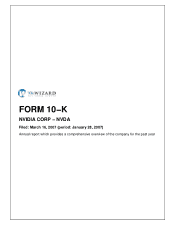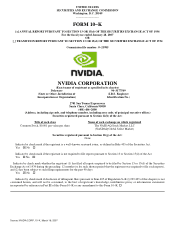NVIDIA 2007 Annual Report Download - page 11
Download and view the complete annual report
Please find page 11 of the 2007 NVIDIA annual report below. You can navigate through the pages in the report by either clicking on the pages listed below, or by using the keyword search tool below to find specific information within the annual report.
Handheld GPUs. Our Handheld GPU product family, known as GoForce, supports handheld PDAs and multimedia cellular
phones.
GoForce. The GoForce family represents our handheld GPUs for a wide range of multimedia cellular phones and handheld
devices. The GoForce 2100 and 2150 are two of the first handheld GPUs to offer hardware acceleration engines for 2D graphics to
manufacturers that support liquid crystal display, or LCD, screen resolutions up to 320 x 240 pixels. The GoForce 3000 and 4000 offer
a host of features for cellular phones and PDAs, including support for up to 3−megapixel image capture, accelerated graphics for
gaming, and motion Joint Photographic Experts Group, or JPEG, capture and playback. Our GoForce 3D 4000, 4500 and 4800
handheld GPUs are the first to provide programmable 3D shaders, along with multi−megapixel still image and video processing in a
single−chip package. Using dedicated hardware accelerator engines, the GoForce family delivers multimedia applications and drives
high−resolution displays, while extending handheld battery life through a variety of power management techniques. In the third
quarter of fiscal 2007, Motorola Inc., or Motorola, and Sony Ericsson Mobile Communications AB, or Sony Ericsson, launched Third
Generation, or 3G, models of their RAZR and Walkman portable phones, respectively, that are both powered by our GoForce GPUs.
Our GoForce handheld GPUs are now shipping in the Motorola 3G RAZR V3X, SLVR L6i, SLVR L7i, MOTORAZR Maxx, and
Sony Ericsson Walkman phones. Our newest handheld GPU, the NVIDIA GoForce 5500 GPU, has been designed into Digital Video
Broadcast − Handheld, or DVB−H, phones in North America, Europe, and Integrated Services Digital Broadcasting − Terrestrial, or
ISDB−T, in Japan.
In February 2007, we unveiled our strategy to target the applications processor market in order to meet the growing multimedia
demands of today's mobile phone user by announcing the availability of the NVIDIA GoForce 6100. The NVIDIA GoForce 6100, our
first application processor, is a low power consumption multimedia solution that supports computationally intensive multimedia
codecs as well as a high quality audio subsystem, integrated WiFi, USB 2.0 and more.
Consumer Electronics. Our Consumer Electronics product group is concentrated in products that support video game consoles
and other digital consumer electronics devices.
Playstation3. In April 2005, we finalized our initial agreement with SCE to jointly develop a custom GPU for SCE's
PlayStation3. SCE launched sales of the PlayStation 3 computer entertainment system in November 2006. We record license and
development revenue from our initial agreement with SCE, as well as from certain additional agreements with them. In addition, in
fiscal 2007, we began to record royalty revenue from SCE based on per unit sales of the PlayStation 3.
Xbox. Our Xbox platform processor supported Microsoft's initial Xbox video game console. The Xbox platform processor
featured dual−processing architecture, which included our GPU designed specifically for the Xbox, or XGPU, and our MCP to power
the Xbox's graphics, audio and networking capabilities. We also have a license agreement with Microsoft relating to the successor
product to their initial Xbox gaming console, the Xbox360, and related devices. We recognized revenue from the sale of our
Xbox−related products to Microsoft for the last time during the second quarter of fiscal 2006.
Our Strategy
We design our GPUs, MCPs and handheld GPUs to enable our PC OEMs, ODMs, system builders, motherboard and add−in
board manufacturers, and cellular phone and consumer electronics OEMs, to build products that deliver state−of−the−art features,
performance, compatibility and power efficiency while maintaining competitive pricing and profitability. We believe that by
developing 3D graphics, HD video and media communications solutions that provide superior performance and address the key
requirements of each of the product segments we serve, we will accelerate the adoption of HD digital media platforms and devices
throughout these segments. We combine scalable architectural technology with mass market economies−of−scale to deliver a
complete family of products that spans professional workstations, to consumer PCs, to multimedia−rich cellular phones.
Our objective is to be the leading supplier of performance GPUs, MCPs and handheld GPUs and application processors. Our
current focus is on the desktop PC, professional workstation, notebook PC, application processor, server, multimedia−rich cellular
phone and video game console product lines, and we plan to expand into other product lines. Our strategy to achieve this objective
includes the following key elements:
Build Award−Winning, Architecturally−Compatible 3D Graphics, HD Video, Media Communications and Ultra−Low Power
Product Families for the PC, Handheld and Digital Entertainment Platforms. Our strategy is to achieve market segment leadership
in these platforms by providing award−winning performance at every price point. By developing 3D graphics, HD video and media
communications solutions that provide superior performance and address the key requirements of these platforms, we believe that we
will accelerate the adoption of 3D graphics and rich digital media.
5
Source: NVIDIA CORP, 10−K, March 16, 2007
























